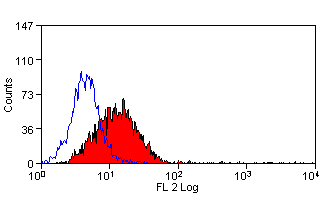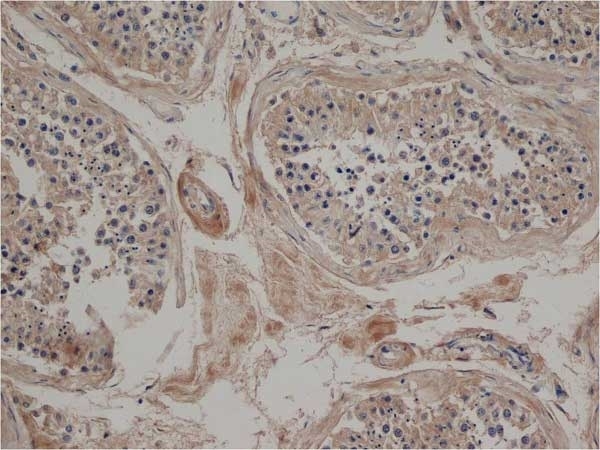JAGGED2 antibody | HMJ2-1


Hamster anti Mouse JAGGED2
- Product Type
- Monoclonal Antibody
- Clone
- HMJ2-1
- Isotype
- IgG
- Specificity
- JAGGED2
| Hamster anti Mouse JAGGED2 antibody, clone HMJ2-1 recognizes Jagged2, one of the five major ligands of the Notch signaling pathway, which is activated through the binding of specific ligands to the Notch receptors Notch 1-4. The Notch signaling pathway is an evolutionarily conserved pathway in multi-cellular organisms, which is vital for cell-cell communication, important during fundamental developmental and physiological processes, including regulation of cell fate decisions during neuronal, cardiac and endocrine development, stem cell hematopoiesis, thymic T-cell development, and both tumor progression and suppression. Ligation of Notch receptors by their specific ligands, Jagged1 (CD339), Jagged2, Delta-like protein 1 (DLL1), DLL3 and DLL4, on physically adjacent signal receiving cells, induces proteolysis of the receptors by ADAM-family metalloproteases and the gamma-secretase complex, within the transmembrane domain, releasing the Notch intracellular domain (NICD) to translocate to the nucleus. Subsequent signal transduction then occurs through either the CSL-NICD-Mastermind complex cascade (canonical pathway), or NF-kappaB-NICD and CSL-NICD-Deltex complex signaling cascades (non-canonical pathway). The canonical pathway inhibits the differentiation of stem cells or progenitor cells, whilst the non-canonical pathway promotes differentiation. Jagged2 is expressed by stromal and thymic lymphoid cells, and by splenic macrophages and dendritic cells (DCs), and plays a vital role during limb, craniofacial, tooth, and thymic development, as well as being implicated in the maintenance and function of neuronal cells in both the central (CNS) and enteric (gastrointestinal) nervous system. |
- Target Species
- Mouse
- Species Cross-Reactivity
-
Target Species Cross Reactivity Rat Human - N.B. Antibody reactivity and working conditions may vary between species.
- Product Form
- Purified IgG - liquid
- Preparation
- Purified IgG prepared by affinity chromatography on Protein G from tissue culture supernatant
- Buffer Solution
- Phosphate buffered saline
- Preservative Stabilisers
- 0.09% Sodium Azide (NaN3)
- Carrier Free
- Yes
- Immunogen
- Jagged2-expressing CHO cells.
- Approx. Protein Concentrations
- IgG concentration 1.0mg/ml
- Fusion Partners
- Spleen cells from immunised Armenian hamsters were fused with cells of the P3U1 myeloma cell line.
- Regulatory
- For research purposes only
- Guarantee
- 12 months from date of despatch
Avoid repeated freezing and thawing as this may denature the antibody. Storage in frost-free freezers is not recommended.
| Application Name | Verified | Min Dilution | Max Dilution |
|---|---|---|---|
| Flow Cytometry | |||
| Immunohistology - Frozen | |||
| Immunohistology - Paraffin |
- Flow Cytometry
- Use 10ul of the suggested working dilution to label 1x106 cells in 100ul.
- Histology Positive Control Tissue
- Mouse spleen
| Description | Product Code | Applications | Pack Size | List Price | Your Price | Quantity | |
|---|---|---|---|---|---|---|---|
| Hamster (Armenian) IgG Negative Control | MCA2356 | F | 0.25 mg |
|
Log in | ||
| List Price | Your Price | ||||||
|
|
Log in | ||||||
| Description | Hamster (Armenian) IgG Negative Control | ||||||
Source Reference
-
Moriyama, Y. et al. (2008) Delta-like 1 is essential for the maintenance of marginal zone B cells in normal mice but not in autoimmune mice.
Int Immunol. 20 (6): 763-73.
References for JAGGED2 antibody
-
Sekine, C. et al. (2009) Differential regulation of splenic CD8- dendritic cells and marginal zone B cells by Notch ligands.
Int Immunol. 21 (3): 295-301. -
Sekine, C. et al. (2012) Differential regulation of osteoclastogenesis by Notch2/Delta-like 1 and Notch1/Jagged1 axes.
Arthritis Res Ther. 14: R45. -
Sekine, C. et al. (2014) Macrophage-derived delta-like protein 1 enhances interleukin-6 and matrix metalloproteinase 3 production by fibroblast-like synoviocytes in mice with collagen-induced arthritis.
Arthritis Rheumatol. 66 (10): 2751-61.
Further Reading
-
Hoyne, G.F. et al. (2001) Notch signalling in the regulation of peripheral immunity.
Immunol Rev. 182: 215-27. -
Sander, G.R. et al. (2003) Expression of Notch1 and Jagged2 in the enteric nervous system.
J Histochem Cytochem. 51 (7): 969-72. -
Iso, T. et al. (2003) Notch signaling in vascular development.
Arterioscler Thromb Vasc Biol. 23 (4): 543-53. -
Bray, S.J. (2006) Notch signalling: a simple pathway becomes complex.
Nat Rev Mol Cell Biol. 7 (9): 678-89. -
Hu, X. et al. (2008) Integrated regulation of Toll-like receptor responses by Notch and interferon-gamma pathways.
Immunity. 29: 691-703
- RRID
- AB_10707936
- UniProt
- Q9QYE5
- P97607
- Q9Y219
- Entrez Gene
- Jag2
- Jag2
- JAG2
- GO Terms
- GO:0005509 calcium ion binding
- GO:0001666 response to hypoxia
- GO:0001709 cell fate determination
- GO:0005887 integral to plasma membrane
- GO:0005112 Notch binding
- GO:0007154 cell communication
- GO:0007219 Notch signaling pathway
- GO:0007283 spermatogenesis
- GO:0007420 brain development
- View More GO Terms
- GO:0008083 growth factor activity
- GO:0008584 male gonad development
- GO:0009912 auditory receptor cell fate commitment
- GO:0030326 embryonic limb morphogenesis
- GO:0042127 regulation of cell proliferation
- GO:0045061 thymic T cell selection
- GO:0045595 regulation of cell differentiation
- GO:0048471 perinuclear region of cytoplasm
- GO:0001501 skeletal system development
- GO:0001701 in utero embryonic development
- GO:0003016 respiratory system process
- GO:0005624 membrane fraction
- GO:0007605 sensory perception of sound
- GO:0042981 regulation of apoptosis
- GO:0016331 morphogenesis of embryonic epithelium
- GO:0030155 regulation of cell adhesion
- GO:0042475 odontogenesis of dentine-containing tooth
- GO:0042492 gamma-delta T cell differentiation
- GO:0007049 cell cycle
- GO:0007220 Notch receptor processing
- GO:0030334 regulation of cell migration
MCA5708GA
MCA5708
If you cannot find the batch/lot you are looking for please contact our technical support team for assistance.
Please Note: All Products are "FOR RESEARCH PURPOSES ONLY"
View all Anti-Mouse ProductsAlways be the first to know.
When we launch new products and resources to help you achieve more in the lab.
Yes, sign me up
